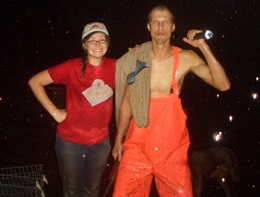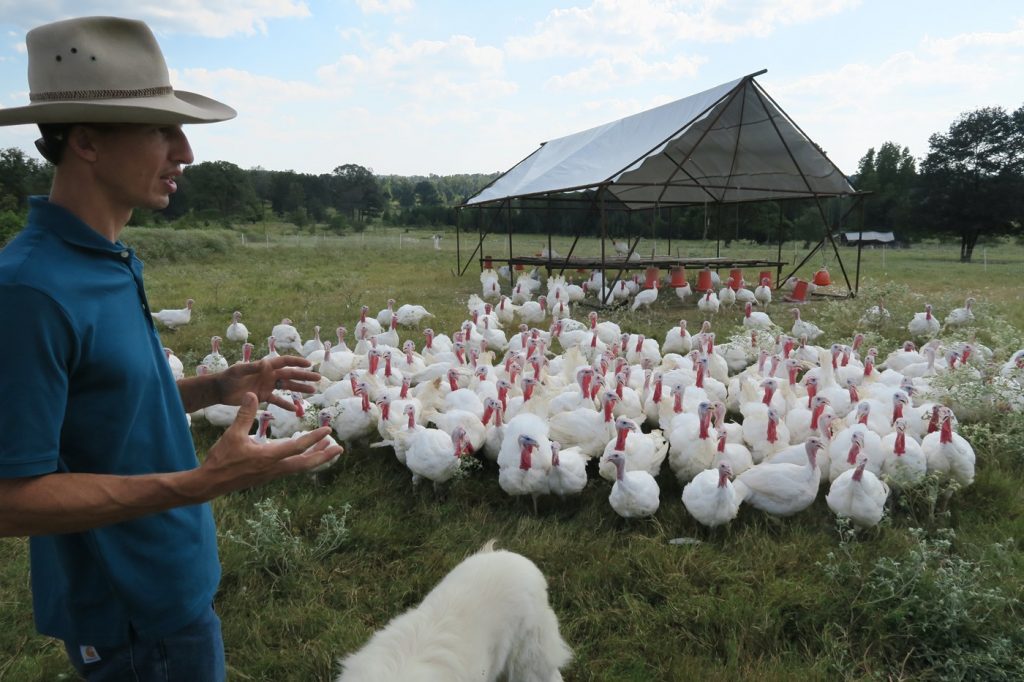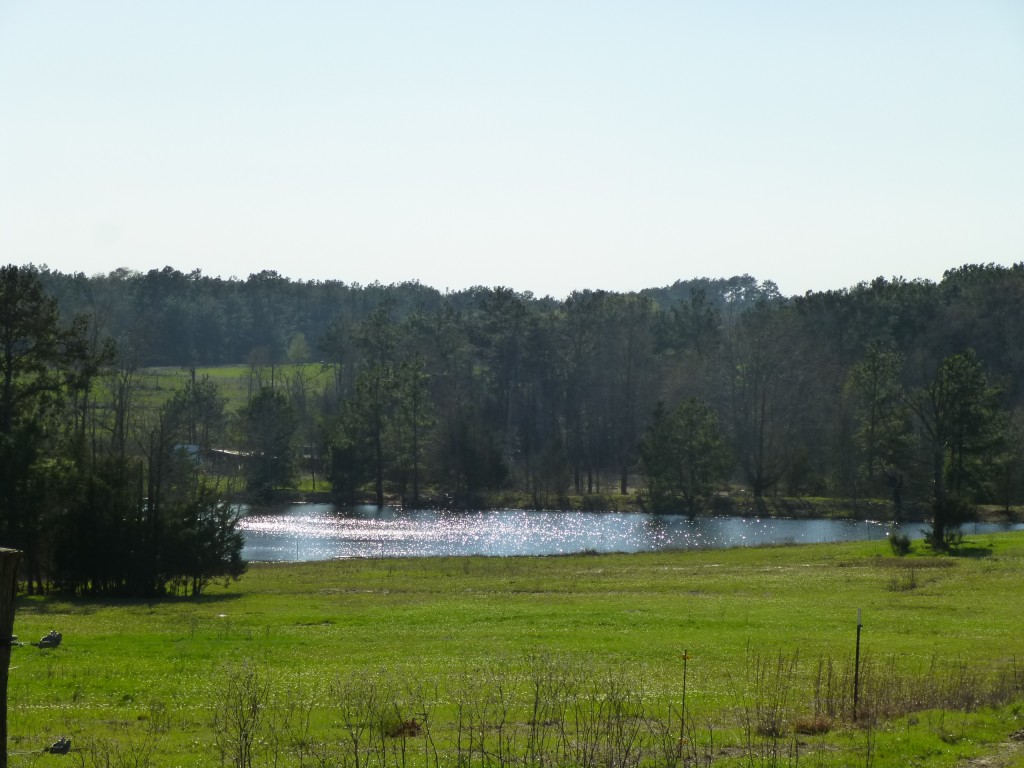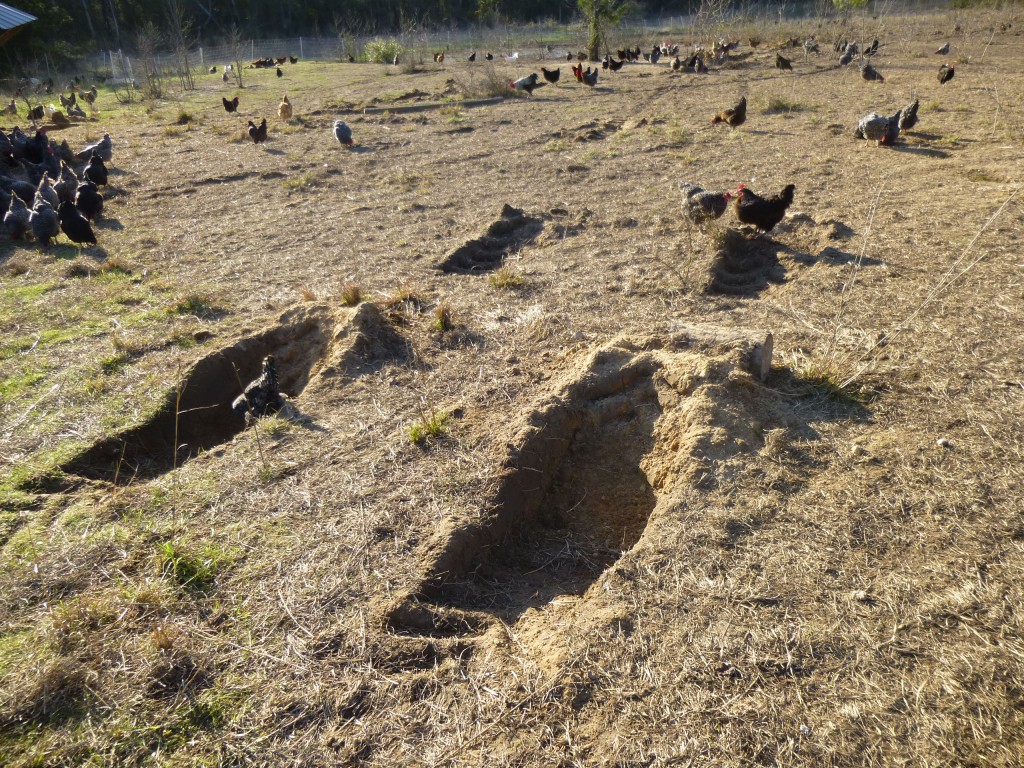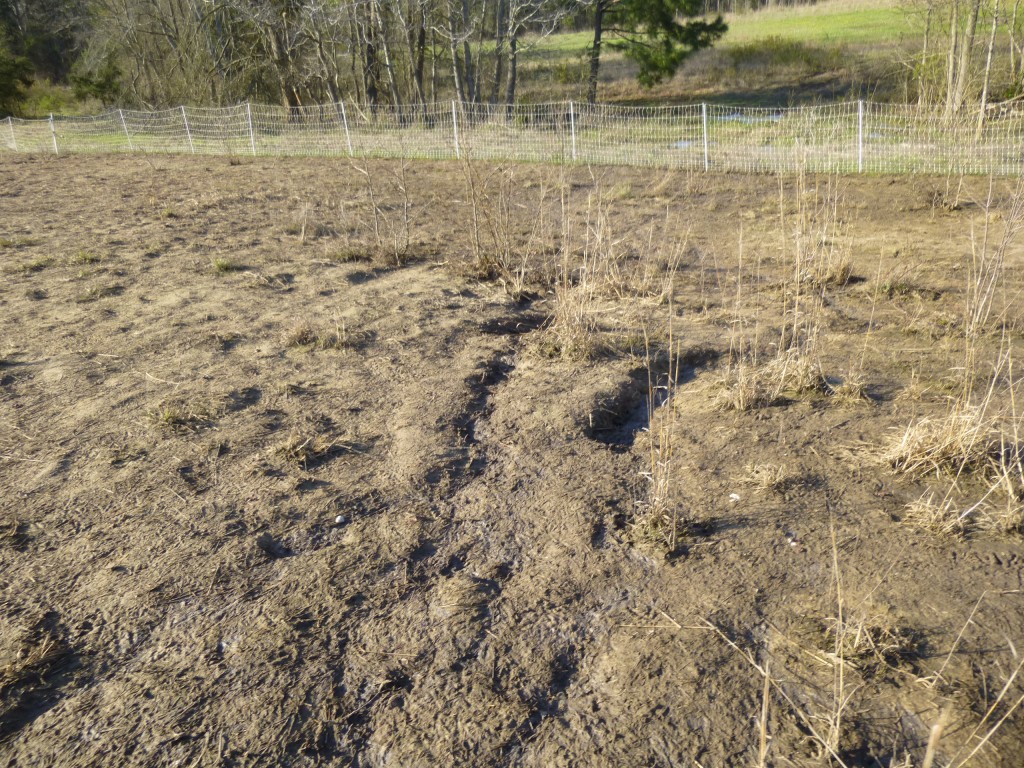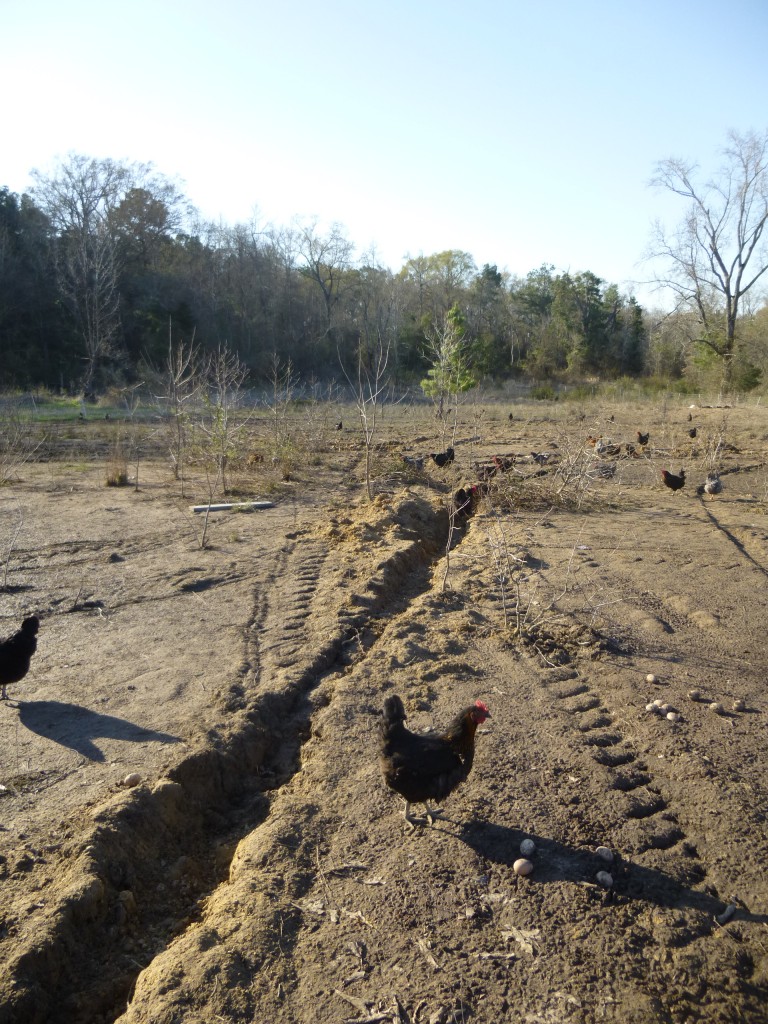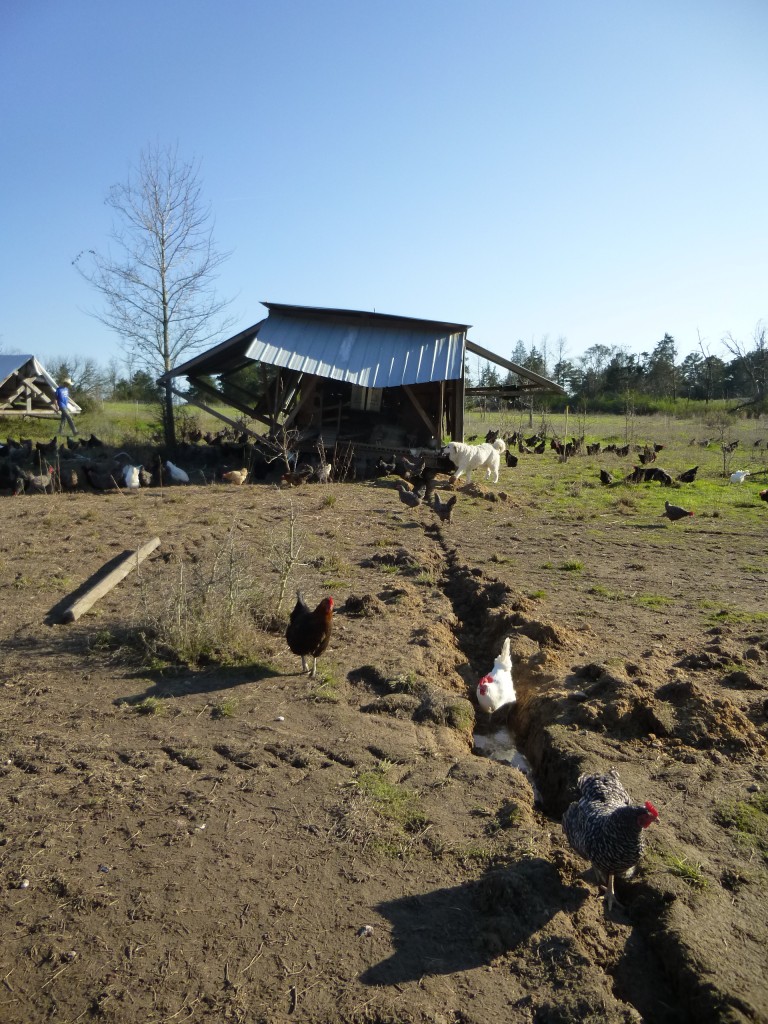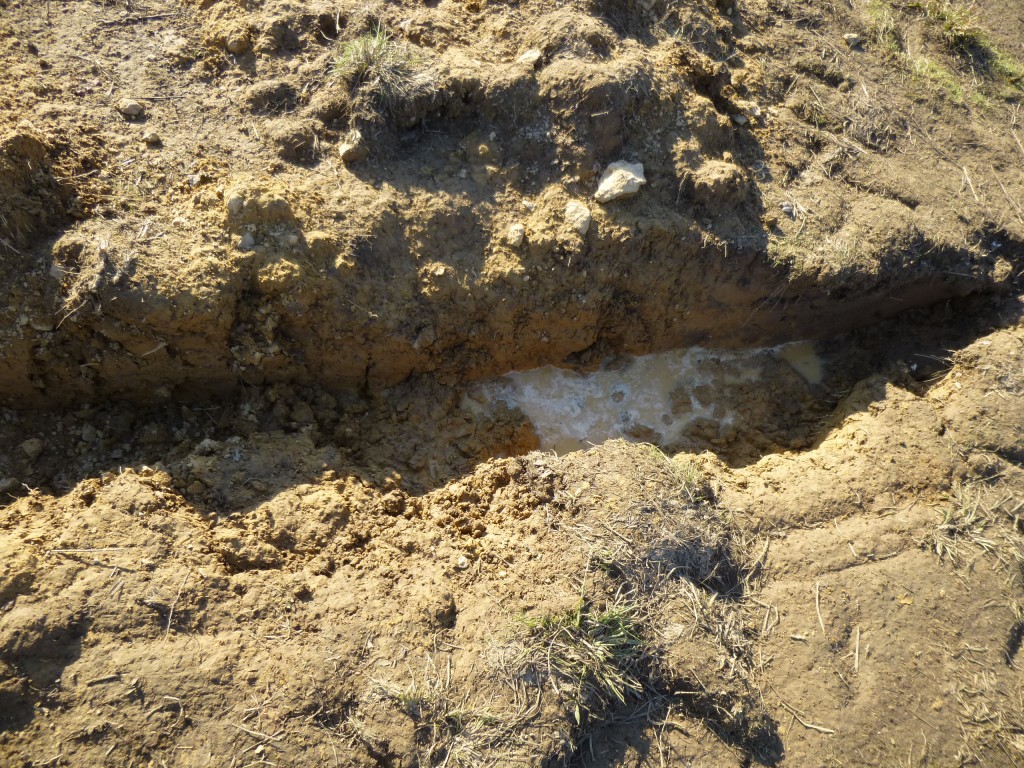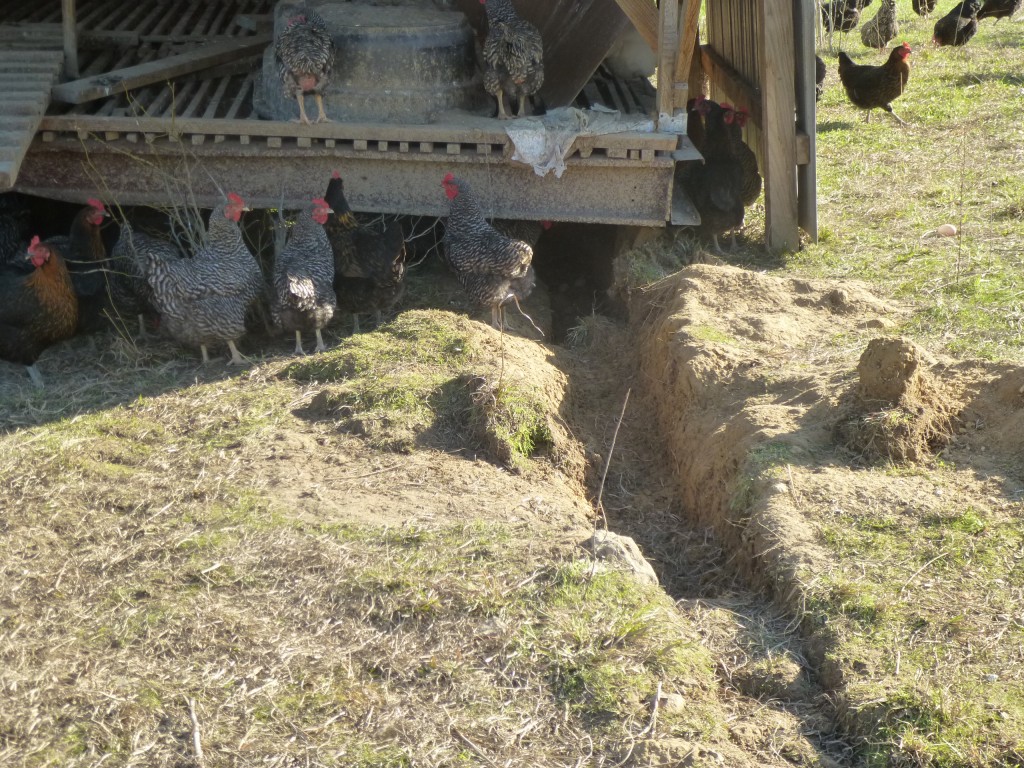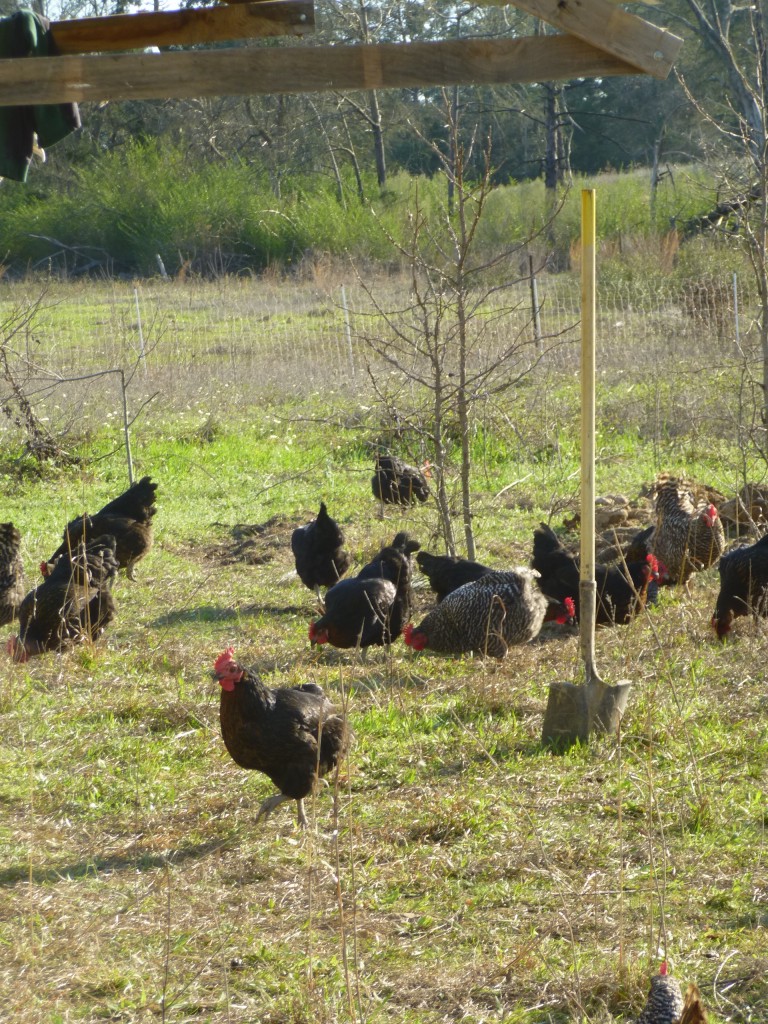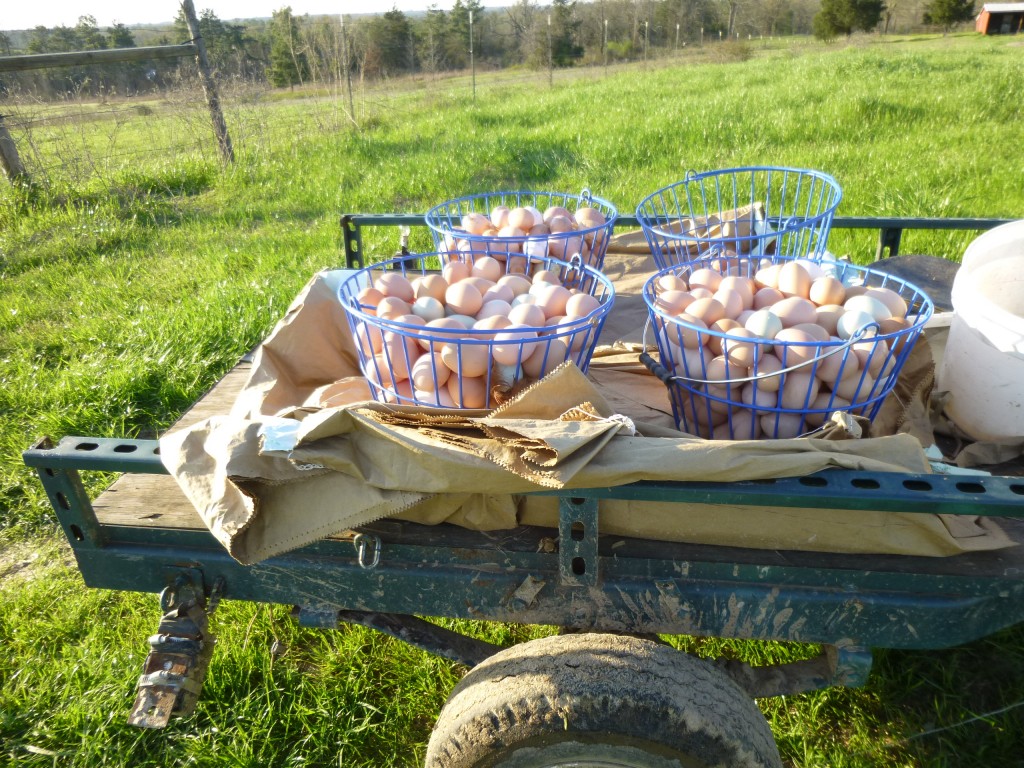A typical Friday night here at Shady Grove Ranch is usually set apart by some special food or drink and the general merriment that comes with the end of a week filled with hard work, long days, and more than could be accomplished by our small team of four people plus two (little) kids. But last Friday night, after the meal of homemade pork pie, we were relaxing and watching a movie, just about ready to turn in for the night, when it suddenly started to rain.
Excitement quietly made its way around the room, “Is that rain? Alright!” Thoughts raced through all our minds, mentally checking off all the lists of things that should have been done in case of rain—did we cover the feed? Did we roll up the vehicle windows? Did we put the tools away? We sat and rejoiced for a few minutes for the long-needed replenishment of our pastures and ponds. After 2 years of drought, you learn never to complain about rain. Still, Matt decided to go make a quick check on the chickens. He slipped on a pair of rainproof overalls and his rubber boots, expecting to be back in a few moments.
The chickens are three weeks old now and can handle a bit of weather. But if they get too wet too fast, they can develop hypothermia and die. (One of the many reasons commercial chickens are raised indoors! It’s not easy keeping these guys on pasture!) There is a big difference between a modern-day meat chicken and a laying chicken. Once grown, laying chickens can handle wind, rain, and even snow. Their fully-feathered exterior protects them against most weather threats.
Meat chickens are only sparsely covered in feathers, bred that way to make plucking and cleaning the carcasses easier. They also happen to be much thicker through the middle (also the result of careful breeding), so even if they had a lot of feathers, it would take a very thick covering to really insulate their bodies well.
So when it is pouring down rain, even in mid-September in Texas, our birds are as exposed as Schwarzenegger in a Speedo on the Atlantic sea coast as a storm blows in (excuse the analogy, but it is a good one). We try to anticipate weather, adding or removing slats of sheet metal to the chicken huts to deflect wind and rain or to allow ventilation. But our precautions were meaningless against this particular storm.
The storm developed quickly. Weather forecasts said we might see up to 1 inch per hour. The birds are located midway down one of our gentle slopes here in Jefferson. Not in a valley at all, but the way their huts are constructed can sometimes lead to pooling water along the lowest edge. This rainstorm ended up dumping almost 3 inches in a little over an hour. Only thirty minutes into it, the chickens were already soaked.
When Matt got there, he realized the birds were drumstick-deep in water that was quickly gushing down the hill. Our pastures have been mercilessly afflicted by the drought, their soils baked by the unrelenting sun for two summers in a row. Despite our efforts at rotational grazing, avoidance of chemicals, and heavy fertilization using animals, the ground just can’t absorb as much water as was falling. Matt began the colossal chore of rescuing the chicks from death, whether by hypothermia, or by drowning when their exhausted little legs couldn’t hold them out of the water anymore.
Inside, Matt’s parents and I were entertaining the kiddos, wondering why Matt hadn’t returned yet. He hadn’t even brought a two-way radio, thinking he’d be right back in as soon as he had made sure all was well with the animals. All was not well.
Finally, Bobbi decided to go see how things were going. She returned a few minutes later, sopping wet, and asked me if I could come out to help. I promptly put the kids to bed, trying my hardest not to show too much worry, and explaining to Shevi that I was going to help Daddy. He is such a perceptive child. He asked, “Daddy hurt?” I smiled and reassured him that, “No, Daddy is not hurt. He is trying to dry off the chickens, because they got wet in the rain. Just like you get wet in the bathtub and Momma dries you with a towel. Momma is going to help Daddy dry off the chickens.” I tucked him in and plugged in the monitor and handed it over to Pap-Pap, along with the 2-way radio. I quickly donned long pants, a raincoat, a hat, gloves, and a flashlight, and headed out the door. You learn to dress fast when you run a ranch.
If you wear corrective glasses like I do, you know how hard it is to work in the rain with glasses. Couple that with working in the dark in a pasture on a hill in the rain. I half-jogged, half-walked down the hill toward the broilers, treading not through puddles, but through one huge puddle that covered the entire ranch. I tried to keep my glasses covered as I scurried toward the chickens so that I could prolong my ability to see clearly. There were inches of water over the whole of our place. I began to fear what I would find at the chicken pens.
When I arrived, it was still pouring, and the rain on the tin roofs of the pens was deafening. In the dim light of our ATV, I saw Matt under one of the pens. I shouted to him for instructions. Bobbi was carrying hay to each pen, and I was to crawl inside and distribute it in a 6-inch-deep bed to put the chickens on. I peered into the huts with my flashlight to assess the damage and the task at hand. Things did not look good. I saw many chickens laying on their sides, eyes closed. I knew they didn’t have long. No wonder Matt hadn’t come back to ask for help. He couldn’t leave. We would have to work fast.
The two pens nearest the bottom of the hill, each with about 100 chickens inside, were the worst. They were at the shallowest part of the slope, so more water had accumulated in their pens than the others. I climbed into the pen with my raincoat and hat on, flashlight in hand. Gloves were useless. Everything was so wet, they wouldn’t help at all. I quickly put them into my pockets. The roof of the pen is very low, maybe only 24” from the ground, so my hat, which was supposed to serve as my cover to keep my glasses dry, would get caught on the support beams, shift down over my eyes, and blind me. I threw it onto the top of the hut, thinking I’d be mostly under the tin, anyway, so I could probably make do.
Down on hands and knees, I began to crawl under the pen with the birds. They were soaked. I began to move the little birds, most of which probably only weigh about 24 ounces, out of the way so I could make a path toward the back of the pen. I dragged hay along the pathway, trying to reason out the best strategy for not crushing any of the birds, not having to move birds twice, and getting as many birds as possible out of the four-inch-deep water as quickly as possible.
It was hard not to get overwhelmed. One of the hardest things in farming is to keep your head when things look bleak. And from under that tin roof—rain pounding down so loud that you can barely hear the chickens weakly peeping for help, army-crawling through mud and litter and pounded-down grass with water 3 and 4 inches deep soaking into your shoes, your pants, your arms—things looked pretty bleak.
The best strategy is not to focus on how bad things look, but rather to focus on the goal and task at hand. The task in this case was to get warm, dry hay and make a bed six inches deep with sides to keep the chicks from falling off into the water. There was only one opening on the 20-foot-long pen, so the hay had to be dragged from the opening to the back of the pen. I had to be careful not to crush any chicks as I dragged the hay into the pen, and I had to move any chicks prior to putting the hay down so that they wouldn’t get trapped underneath and smother. Then the chicks had to be placed on the warm bed and frequently spread out so they wouldn’t crowd each other in attempt to get warm, else they should suffocate.
I began my task in the pen at the lowest part of the hill—under the hut in the worst shape. First I cleared a path to the back of the pen and assessed the highest and driest part of the pen where I would lay hay first. Then I assessed which chickens were in the worst shape, and tried to focus on those first. I built a bed of hay in the back corner and started gently tossing chickens onto it. Once I cleared out one area where chickens had been standing in water, I could then fill that space with more hay, making room for more chickens. I had to leave myself a path so I could crawl back and forth, grabbing as much hay as I could drag while crawling on elbows and knees through the pen.
My raincoat was doing little to keep my dry, since most of the wet I was experiencing was coming from the pool on the ground. I finally took a moment to crawl back to the opening of the pen and remove the coat so I could better maneuver in the tight space under the roof. When I dragged the next armful of hay to the back of the pen, I realized that much of the hay I had already put down now had more inches of water on top—the birds were standing in water again!
About this time, Matt checked in on me, and I told him that the water kept getting higher. He asked if I needed help, but I decided to keep working alone, knowing that he had other pens to tend to. I asked Bobbi to bring me more hay. I started my task over again, moving the birds out of the water, stacking the hay double of what I had last time, piling it highest near the driest (really, the least wet) corner of the pen. Then I began quickly moving the birds back onto the dry hay, adding more hay where those birds were standing, the moving more birds onto that spot. It felt like one of those Chinese square puzzles. Finally, all the birds were out of the water, and where I crawled on hands and knees, much of it was dry hay instead of underwater grass. There was hope.
The birds, however, were still crowding each other—not good. When chickens, especially young chickens, get really cold, they start standing on top of one another, sacrificing the bottom guys to save the ones on top. The ones on bottom don’t put up much of a fight, and this is probably our fastest bird-killer when the birds are young like this. I started weeding through the bunches of soggy, clammy white bodies, tossing the stronger ones near stronger ones and moving the weaker ones to more spacious areas so they could recover without the oppression of the ones more likely to survive.
Matt came over to check on me again, and he said my batch looked pretty good. I was glad to be done, but daunted by the idea that we had 4 more pens to go. Once again, I army-crawled back to the opening, ducking my head against roof screws and low-hanging support beams. I stood and stretched and looked by the light of the ATV at the rest of the pens. Taking my tiny flashlight (it’s times like these when you find the weaknesses in your emergency plans and supplies), I quickly shone it in at the other birds to see how they looked. I heard faint chirping and saw upright legs and movement, which were good signs.
Now Matt called our attention to the rest of the hay bale. We could stack hay on the north side of each pen to help dissuade more water from rolling down the hill into the pens, and would help to maintain the heat that the little birds inside were busy generating atop their new dry hay beds. I tried not to think about how hard it would be to move the cages tomorrow after the rains. All the hay would act as an anchor under the pens. But we would cross that bridge when we came to it. For now, our mission was to keep them alive.
We unrolled more hay off the oversized round bale. Despite the continuing heavy rain, the unraveled bale created a huge amount of dust that lit up in the light of our ATV and made us cough and sneeze. But we hurried to carry it to each of the six pens, piling it thickly along the north side, peeking in at the chicks one last time before we covered their houses.
Finally we had done as much as we could do. Exhausted, we gathered our supplies, clothes, and flashlights, and headed back home. As the adrenaline wore off, we began to feel just how wet and dirty we were. There was grass everywhere—in our hair, under our shirts, in our shoes. We tried not to think about how much chicken poop was once on top of that grass (natural fertilizer, you know), and hoped that most of it had washed away before we got there.
Back at the house, we stood dripping in the falling rain and removed as much clothing as was decent. But we took a picture first, just to have the memory of this so-absurd-it’s-funny experience. I walked into the house first, headed straight to the shower, when I saw the computer screen was on. I glanced over to find my 2.5-year-old son sitting at the desk, clicking away at emails, documents, and programs! I was surprised he was up by himself, and guessed that he was too worried to go to bed and had come back out of his room after I left. I told him I would take a shower and be back out—I couldn’t very well hold him as filthy as I was. So I took the ultra-fast version of the shower I had longed for, dressed, and came back out to get him.
Once we were all cleaned up and dried off, we ventured to the living room to relax and laugh at our crazy lives. Despite the destruction among the chickens, we were giddy over the 2.5 inches we had already gotten. We had been looking at a continually falling water level in our ponds and hoping for enough rain to get at least one hay cutting on our own property this year. We are always glad for rain, even if it means extra preparations or work (which it usually does). I was also grateful that many other things hadn’t gone wrong. We didn’t lose power, for example, which would have mean no real showers without the generator running, and that’s an ordeal of its own. The wind wasn’t bad, so we didn’t have to worry about tornados or falling trees. It was pretty warm, and the chicks weren’t totally new to pasture, so they had a fighting chance of survival.
We also had experience on our side, having experienced a worse, colder storm in 2011 with 2-week-old chicks that had just been moved out to pasture that afternoon. We used the same technique—bunching hay around the chickens and getting them upright, out of the water. It worked then, and we were confident that it would work now.
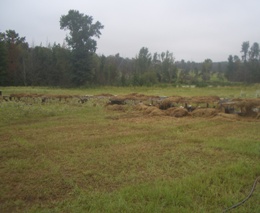 The damage assessment the next morning revealed success. Out of over 700 chickens, only 12 or so dead. Had we done nothing, or not known what to do, it might have been closer to half of the birds lost, maybe even most of them. We are so grateful to God for the rain, for the wisdom, and for the amazing fruit of the work of our hands. When we harvest these chickens in October, you’d better believe they’ll be our tastiest yet!
The damage assessment the next morning revealed success. Out of over 700 chickens, only 12 or so dead. Had we done nothing, or not known what to do, it might have been closer to half of the birds lost, maybe even most of them. We are so grateful to God for the rain, for the wisdom, and for the amazing fruit of the work of our hands. When we harvest these chickens in October, you’d better believe they’ll be our tastiest yet!
